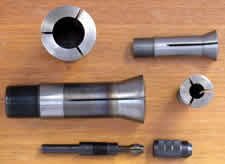- 01: Introduction
- 02: History
- 03: Propellants, Firearms, and Ammunition Development
- 04: Modern Firearms Manufacture
- 05: Small Arms Ammunition
- 06: Evidence Handling Procedures
- 07: Equipment and Instrumentation
- 08: Examination of Firearms
- 09: Cartridge and Shotshell Examination
- 10: Characterization and Evaluation of Fired Projectiles
- 11: Bullet Comparison and Identification
- 12: Gunshot Residue and Distance Determination
- 13: Toolmark Identification
- 14: Communicating Results
- Resources


Head-Turning Operations
Home > Small Arms Ammunition > Cartridge Case Manufacture > Head-Turning Operations
The next operation finishes the exterior shape of the case head. Head turning is performed in a small automated lathe, with the cutter blade mounted at ninety degrees to the long axis of the case so that it can create all needed surfaces in one pass. When the factory switches from producing 30-30 Winchester cases to manufacturing 5.56 mm NATO cases, the cutter is changed to meet the new specifications.

Collets
The head turning machine grips the cases in a collet, a hollow die with longitudinally split walls that can grip and release a round object. When the case is fed into the machine, force is removed from the collet, allowing it to accept the next case to be processed. As the case seats, the machine applies pressure to the collet forcing it to firmly grip the case. The case and collet spin to high speed before the cutter touches the case, ensuring a clean accurate cut. The collet opens and a punch dislodges the case. Good head-turning machines will process 60 to 120 cases per minute.
Some head turning machines can also drill or punch the flash hole, which is the hole that allows fire from the primer to reach the propellant charge. If the case will be loaded (as opposed to being sold as a component), the maker will probably punch the flash hole in the case just before the primer is inserted on a device called a pierce-and-prime machine.




